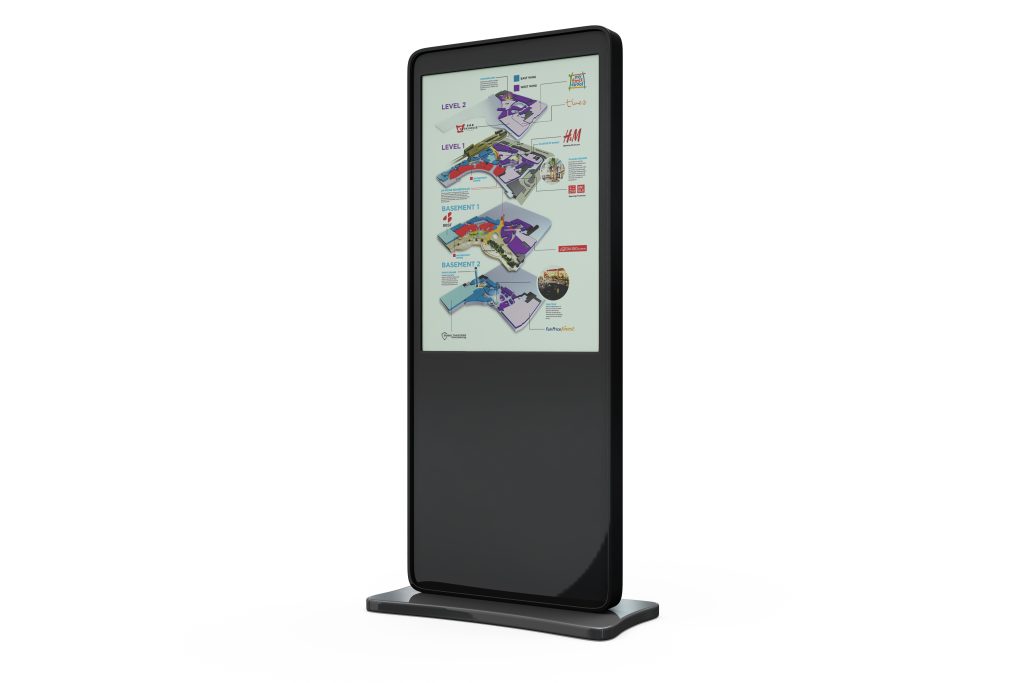Introduction
Mounting a monitor vertically or in portrait mode is a game-changer in productivity and screen space optimization. While often seen in coding or programming environments, this unconventional setup is useful for anyone interacting with long-form content regularly.
By flipping your monitor to a vertical orientation, you align the display with the natural, vertical flow of content, making reading and scrolling through web pages, documents, and codes much more efficient. The additional vertical space reduces the need for constant scrolling, which can be a significant time-saver.
This unique arrangement also offers distinct ergonomic advantages. A vertical monitor allows for a better alignment with your field of vision, reducing the need to move your neck sideways constantly. This can help minimize neck strain risk and improve comfort during long working hours. Indeed, the benefits of a vertical monitor setup extend beyond instinctive advantages to significantly enhance your workday productivity and comfort.

Rising Trend of Vertical Monitors in Various Fields
In recent years, vertical monitors have been on an upward trajectory across various industries and workspaces. Beyond coding and programming, other professions are discovering the utility of such a setup.
For example, in the writing and editing sector, professionals find that the vertical monitor offers a more convenient way to review long documents, eliminating excessive scrolling. Similarly, in digital art and design, portrait orientation can be beneficial for creating and viewing portrait-oriented content like posters, flyers, and social media graphics.
Moreover, with the evolution of the work-from-home culture, many remote workers are optimizing their home setups with vertical monitors to enhance productivity. This growing popularity of vertical monitors underscores a broader trend towards more ergonomic and efficient digital workspaces, catering to the diverse needs of modern professionals across industries. Many remote workers also want top-rated vertical monitors to make their stay-at-home experience more comfortable.
Vertical Monitor History
Vertical monitors have emerged from the traditional landscape orientation that has long been the standard for computer displays. The horizontal or landscape layout was initially adopted because it mimicked the field of vision of the human eyes, which is wider than tall. This format also aligns with traditional media formats such as television and cinema, and it was ideal for the early use cases of computer systems, which were primarily for entertainment and gaming.
However, the advent of the World Wide Web brought about an essential shift. As internet usage grew and the nature of digital tasks began to change, the need for screen layouts that could accommodate long, scrollable content became increasingly apparent. This need was particularly prominent in programming and coding fields, where developers often have to navigate through large text and code blocks.
Recognizing this, manufacturers started to design monitors that could be easily rotated to portrait orientation. These initial vertical monitors were primarily targeted at coding, programming, and designing professionals. However, as the digital landscape continued to evolve, the vertical monitor began to find applications in various other fields, from writing and editing to digital art and design.
Today, the vertical monitor is an increasingly common sight in modern workspaces, offering a highly efficient and ergonomic solution for a wide range of digital tasks. The rise of vertical monitors represents a significant shift in digital workspace design, underscoring the growing importance of adaptability and customization in response to the changing needs of the digital era.
Shift in Preference Towards Vertical Orientation
The shift in preference towards vertical monitors can be attributed to several reasons. Firstly, vertical monitors align with the natural flow of many online tasks. Web pages, documents, and coding blocks flow vertically, making a vertical monitor more suitable for viewing such content. Vertical monitors eliminate excessive scrolling, providing an efficient solution for reviewing lengthy documents or codes.
Secondly, the vertical orientation of monitors offers notable ergonomic advantages. This setup aligns better with your vertical field of vision, reducing the need for lateral neck movements. As a result, it reduces strain and improves comfort during extended work periods.
Lastly, the customization options provided by vertical monitors significantly contribute to their popularity. A vertical monitor can easily be incorporated into multi-monitor setups, offering the flexibility to choose the orientation based on the task. This adaptability makes vertical monitors an increasingly popular choice for professionals across various fields, from programming and writing to digital art and design.
Accessories Required To Mount Vertical Monitor
To effectively mount a monitor in a vertical position, specific accessories are crucial. These tools not only facilitate the mounting process but also ensure the stability and flexibility of your setup.
- Monitor Stands: Monitor stands are fundamental accessories for installing a vertical monitor. They provide a solid foundation for the monitor and ensure it remains stable in the desired orientation. When buying a monitor stand, ensure it is compatible with the size and weight of your monitor and that it allows rotation to a vertical position.
- Wall Mounts: If you prefer a cleaner look or need to save desk space, wall mounts are a great option. They secure your monitor directly to the wall, allowing you to position it at an optimal height and angle for comfort. Wall mounts are designed to hold monitors securely in place, whether in a horizontal or vertical orientation. Ensure the mount is VESA-compatible – a standard adopted for mounting flat screens on walls.
- Adjustable Arms: Adjustable monitor arms offer the greatest flexibility in positioning your monitor. They can be attached to your desk or wall, allowing you to easily change the monitor’s height, tilt, swivel, and rotation. This is particularly beneficial for vertical monitors, as you may need to fine-tune the viewing angle for comfort or based on the content being displayed. When choosing an adjustable arm, factor in the monitor’s weight to ensure it can support it securely.
These accessories are indispensable when setting up a vertical monitor. By selecting the right tools, you can ensure a safe and ergonomic setup that improves your workspace’s efficiency and comfort.
Importance of Selecting Suitable Accessories
Choosing the right accessories for mounting a vertical monitor is paramount for stability, adjustability, and ergonomic comfort. The stability of the monitor is crucial as it prevents any unwanted movement or vibration that can disrupt your work or, worse, cause damage to the monitor.
The adjustability offered by accessories such as monitor arms can significantly enhance the flexibility of your setup, allowing you to rotate, tilt, or change the monitor’s height based on your needs. This is particularly important in a vertically oriented monitor as the optimal angle may vary depending on the content displayed.
Lastly, the ergonomic comfort provided by a well-chosen monitor stand or arm can drastically improve your work experience. It allows you to adjust the monitor at an optimal height and angle, reducing the risk of neck strain or other discomforts during extended work periods. Therefore, investing time and thought in selecting suitable accessories for your vertical monitor setup can significantly improve productivity, comfort, and overall work experience.

How To Setup A Vertical Monitor?
Setting up a vertical monitor is relatively straightforward. Below are the steps you need to follow:
Step 1: Choosing the Right Monitor
Choosing the right monitor is crucial for a successful vertical setup. Here are some of the critical factors to take into account:
- Size: The size of the monitor will determine the amount of content you can view without scrolling. Bigger monitors can display more content but take up more space. Make sure to consider the size of your workspace and your viewing distance while selecting the monitor size.
- Resolution: The monitor’s resolution refers to the number of pixels displayed on the screen. Higher resolution means sharper images and text, which is crucial when working with extensive documents or detailed images. For a vertical monitor, a resolution of at least 1080p is recommended for a clear and sharp display.
- Connectivity Options: The monitor should have enough ports for all your devices. Check the types of ports available (like HDMI, DisplayPort, USB-C) and ensure they are compatible with your computer’s outputs.
- Rotation Capability: Not all monitors are designed to be used vertically. Ensure your monitor can be easily and securely rotated to a vertical orientation.
- Aspect Ratio: The aspect ratio is the width of the screen relative to its height. A monitor with a 16:9 aspect ratio is usually a good choice for a vertical setup, as it offers a wide viewing area when rotated.
- VESA Compatibility: If you plan on using a wall mount or adjustable arm for your vertical monitor, ensure it is VESA compatible. VESA is a standard adopted for mounting flat screens and guarantees that the monitor and mount will fit together perfectly.
Considering these factors when choosing a monitor for vertical use, you can ensure you get a setup that fits your needs and enhances your productivity and comfort.
Step 2: Adjusting Monitor Settings
Once you have physically mounted your monitor vertically, you need to adjust the display settings on your computer to match this new orientation. The process varies depending on whether you use a Windows or Mac system.
Windows Users
- Right-click anywhere on your desktop and select “Display settings” from the drop-down menu.
- Scroll down to the ‘Orientation’ drop-down menu in the new window.
- If you have multiple monitors, make sure you’ve selected the display that you’ve rotated.
- From the ‘Orientation’ drop-down, select ‘Portrait’ to rotate the display 90 degrees. If you’ve mounted your monitor upside down (which some people do to get the connectors on the bottom for easy access), select ‘Portrait (flipped).’
- Click ‘Apply,’ and a pop-up will appear asking if you want to keep the changes. If everything looks good, click ‘Keep changes.’ If something goes wrong, don’t click anything; it will auto-revert after 15 seconds.
Mac Users
- Click on the Apple logo in the top-left corner of the screen and select ‘System Preferences.’
- Navigate to ‘Displays,’ then click on the ‘Display’ tab if you still need to select.
- Hold down the ‘Option’ key on your keyboard, making the ‘Rotation’ option appear.
- From the ‘Rotation’ drop-down, select ’90’ to rotate the display 90 degrees. If you’ve mounted your monitor upside down, select ‘270’.
- Click on ‘Confirm’ to save the changes.
Remember that if anything goes wrong or doesn’t look right, you can always revert to the original settings by following these steps.
Step 3: Mounting the Monitor
Mounting a vertical monitor involves carefully handling and properly using your chosen mounting accessories. Here are the steps you should follow:
- Setup Monitor Stand: If your monitor has a stand that supports vertical orientation, attach the stand to the monitor according to the manufacturer’s instructions. Many monitors have a quick-release button or screw on the back, allowing you to attach the stand easily.
- Attach to Wall Mount or Adjustable Arm: If you’re using a wall mount or adjustable arm, first secure the mount or arm to your wall or desk. Make sure it’s tightly fixed and capable of supporting the weight of your monitor. The mounting process varies depending on the product, so refer to the manufacturer’s instructions.
- Attach Monitor to Mount: Attach your monitor to the mount or arm. Most monitors and mounts follow the VESA standard, so simply line up the holes on the back of your monitor with the holes on the mount. Insert the provided screws and tighten them securely. Be careful not to over-tighten, as this can damage the monitor.
- Rotate to Vertical Position: Now, carefully rotate your monitor to a vertical position. You can also adjust the height, tilt, and swivel using an adjustable arm for optimal viewing comfort.
- Connect to Computer: Connect your monitor to your computer using the suitable cable. Ensure the cable is securely inserted into the correct port on your monitor and computer.
Remember, every setup and monitor model may have unique features and requirements. Always refer to the user manual or manufacturer’s instructions when setting up your vertical monitor.
Step 4: Cable Management
Effective cable management is crucial to maintaining a clean, organized workspace and preventing accidents from tripping over loose cables. Here are a few techniques to help you manage your cables effectively:
- Use Cable Ties or Clips: Cable ties or clips are simple tools that can bundle cables together, making them neat and less noticeable. They come in various types – from plastic zip ties to velcro strips – and can be easily attached and detached, making them perfect for frequently modified setups.
- Cable Sleeves or Tubes: Cable sleeves or tubes are ideal for bundling multiple cables into a single, neat package. They organize the cables and provide them with a layer of protection.
- Cable Trays or Raceways: If you have a lot of cables running across your desk or along your walls, consider using cable trays or raceways. These accessories can be attached under your desk or along your wall, providing a designated path for your cables and hiding them from view.
- Use a Cable Box for Power Strips: Cable boxes are designed to house your power strips and associated mess of cables. With a cable box, you can have all your cables and power strips in one place, hidden away from sight.
- Label Your Cables: It’s easy to forget which cable is which when you have many running through your setup. Labeling your cables allows you to easily identify them without having to trace them back to their source.
- Use Wireless Devices Where Possible: One of the best ways to reduce cable clutter is to switch to wireless devices. This might only be possible for some of your devices, but even changing one or two items to wireless can make a significant difference.
Remember, the key to effective cable management is regular maintenance. Take the time to periodically check and reorganize your cables to ensure your workspace remains clean and organized.
Step 5: Ergonomic Considerations
When setting up a vertical monitor, paying special attention to ergonomics ensures a comfortable and strain-free work environment. Appropriate positioning of the monitor can significantly decrease the risk of musculoskeletal disorders and eye strain.
- Monitor Height: The top of the screen should be at or slightly below eye level when seated comfortably. This position allows you to view the screen without bending your neck. If the monitor is too high or too low, it can lead to neck and shoulder pain.
- Monitor Angle: The monitor should be tilted back slightly, around 10 to 20 degrees. This angle is generally the most comfortable viewing a monitor and reduces the risk of straining your eyes and neck.
- Monitor Distance: The monitor should be at arm’s length, approximately 20 to 30 inches from your eyes. This distance reduces the strain on your eyes and helps prevent conditions such as Computer Vision Syndrome, which includes symptoms like blurred vision, dry eyes, and headaches.
- Eye Level: When looking straight ahead, your gaze should naturally fall on your browser’s address bar. This reduces the need for neck movement and promotes a more comfortable and ergonomic setup.
-
- Document Position: When working with paper documents in addition to your monitor, use a document holder positioned at the same height and distance as your monitor so you don’t have to turn your head or change your eye focus repeatedly.
Adhering to these ergonomic guidelines can significantly improve your comfort and health while working with a vertically mounted monitor. Regularly adjusting your setup and taking breaks to rest your eyes and muscles contribute to a healthier work environment.
Conclusion
Mounting a vertical monitor can significantly enhance your workspace’s ergonomics and productivity, particularly for tasks involving extensive reading, coding, or data handling. The process consists in selecting the suitable monitor, adjusting its settings, meticulously mounting it, managing the cables, and setting it up ergonomically. While it may seem daunting initially, the benefits of a vertical monitor setup make the effort worthwhile. Remember, the key lies in personalizing your workspace to your comfort and needs, so don’t hesitate to experiment with different setups, monitor positions, and accessories. Here’s to a more comfortable and productive workspace with your new vertical monitor setup!



